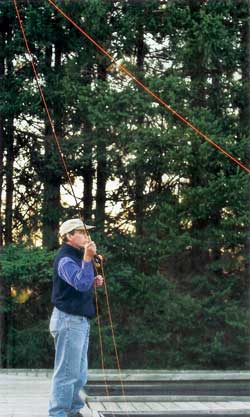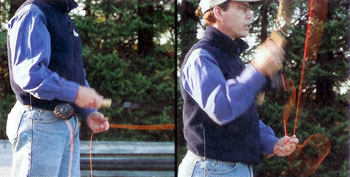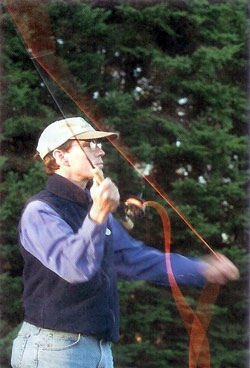Beyond Competence, Part I

The roll-cast pickup allows you, with just a flick of the tip of your rod, to get the line in the air from a high-rod-tip position at the end of a dry-fly drift. Craig Uecker photo.
IF YOU CAN FINALLY CAST the fly out to about 45 feet comfortably, shoot some line, and make a decent roll cast, you are officially a competent fly caster. Now what? What do the experts do that you don’t? How did that guy hook all those fish while you were struggling to get your first of the day, using the same fly? Clearly, these questions have multiple answers, but the most important is that the expert can put his fly right where he wants it almost every time. He puts it there with whatever slack he may need. And, he does so in very little time and with few blown casts. To use a golf analogy, he has played the same water as you, but he has done it in fewer strokes.
In this column and the next, we’ll focus on some of the little casting things that experts do that add up to more fish. We’ll start with the pickup and backcast. In the next installment, we’ll look at sidearm casting and shooting on the reach cast.
The Slide Pickup
This technique could also be named the “shoot pickup” because you allow line to slide out through the guides — as when you shoot — during the pickup. Why do this? Because it’s a stroke saver. By sliding line out during the pickup, you extend the amount of line beyond the tip for the backcast. This saves you a stroke on the forward or backcast. And that extra mass of line, as it unrolls during the backcast pause, will exert more pull on the line if you want to shoot during either the backcast or forward cast pause (or both). With more line shooting out during either pause, you’ll save roughly one more stroke. So the slide pickup, done correctly, can save you two strokes. Your fly spends more time in the water and less time in the air, where it’s unreachable by hungry jaws.

Executing the slide pickup: As you raise and pivot the rod during the pickup, allow the line to slide over your fingers (left). When the rod reaches about the 10 o'clock position, pinch the line (right) and make a normal backcast. Craig Uecker photo.
Now, let’s do it. I’m a big fan of practicing on lawns, but you’ll need water’s steady surface tension for this one. Begin with 20 feet of line — excluding the leader — beyond the rod tip. Start with your rod tip pointing down at the water. (When I fish from my kickboat, my tip-top touches the water.) Cradle the line in your line hand so that it drapes over your open fingers. To enable it to slide over your hand during the pickup, your thumb will be barely above the line, ready — at the right instant — to pinch. As you raise and pivot the rod during the pickup, allow the line to slide over your fingers. When the rod reaches about the 10 o’clock position, pinch the line and make a normal backcast. Your first few dozen attempts may be ugly. You’ll sometimes lose control of the line during this maneuver, as I do. It happens to everybody, but it happens less as you practice it more. And the pickup may feel a bit jerky because of the sudden extra load on the rod the instant after you pinch the line.
You’ll notice that it’s a little harder to get a good backcast with this type of pickup. This is because you’re effectively starting the pickup from a high-rod-tip position, having used most of the usual pickup motion to slide line out through the guides instead of up from the water. At first, try not to change the style of your pickup as you concentrate on the sliding; you need an efficient stroke here. The more efficient your pickup and backcast, the easier the slide pickup will be. In other words, the less extra body motion you do to make a high-rod-tip backcast, the easier this will be.
Now, because you’ve added line to the backcast by sliding, you’ll need a slightly longer backcast stroke than you would have needed had you not slid line. If you don’t have enough room left to make a good backcast, you can follow the slide pickup with the roll-cast pickup. (See below.) When well executed, this will gently aerialize the line from the water and allow you to then make a good backcast.
Roll-Cast Pickup
On my almost-annual trip to the Yellowstone River, my wife and I were backpacking the Black Canyon, a remote stretch of the river in Yellowstone National Park. One day, the hopper conditions were dreamy, and I was eager to fish all the cool, new, foam-bodied, flashy, fluorescent, and parachuting patterns in my hopper box. But, initially, I got more refusals than takes.
In my delicious frustration at all the near-miss refusals, at the end of every drift I wanted the fly drifting right back over those cutts — as fast as possible. Because it let me smoothly pick up line from a high-rod-tip position, the roll-cast pickup was the ticket. As soon as the fly was below where I wanted it, I made a roll-cast pickup, then a single backcast, and then a forward cast and delivery. I was able to quickly, easily get many drifts over cutthroats that were eager to take the right fly. I’d sometimes see one fish refuse the same fly three or four times. Changing flies often, I finally hit on a consistent winner, a tandem rig with a big Dave’s Hopper up front and a small Dave’s Hopper trailing about a foot behind. According to the fish on that day, Dave’s is still the gold standard in grasshopper imitations.

To increase line speed during the pickup, use a single haul that accelerates in time with the rod's acceleration, and it should have its abrupt stop at the same instant as the rod's. Craig Uecker photo.
Once you’ve made a true roll-cast stroke, two things happen. The line lifts off the water; then the momentum in the loop (yes, a roll cast has a loop just like a forward cast or backcast) pulls the trailing line and fly farther out from the caster. But in the roll-cast pickup, we only want the first thing to happen; we don’t want to put enough momentum in the loop to make it put the fly out farther.
From a high-rod-tip position at the end of your dry fly’s drift, barely flick the tip of the rod forward. Make this flick before you get a belly or sag of line behind the rod. This will lift the line, leader, and fly off the water but won’t lengthen the line in front of you or put the fly out farther. (Because you started without a belly of line sagging behind the rod, a true roll cast that lengthens line in front of you is not possible.)
Here is a drill to help you practice this roll-cast pickup: With the line on the water, do what feels like a mini roll-cast, with just a tiny tip-flick. Remember, you aren’t trying to make a conventional roll cast here. Once you get the line so that it just lifts off the water, without carrying the fly farther out, practice doing it with the shortest forward rod rotation possible. After you feel good with that one, try a different drill, one in which you make the tip travel laterally during the roll-cast pickup. Instead of flicking the tip straight ahead, flick it with a tiny out-and-in wrist roll. The maneuver should lift the line so it describes a more horizontal loop than the traditional vertical roll cast loop. This tends to keep the fly from ticking the water when you make the backcast after doing a roll-cast pickup.
Single Haul
There were a few times during that great hopper day on the Yellowstone when I was fishing way out, where the water looked too good to pass up just because it was 65 feet away. During those times, to keep my strokes to a minimum, I used a single haul during the pickup and backcast. Without the haul, I would have had to strip in enough line to be able to make a comfortable pickup and backcast, and then I would have had to shoot line back out to 65 feet. That would have cost me an extra stroke or two and precious seconds of fishing over treasured holding water.
A haul is a pull or tug on the line that is normally done during the backcast or the forward cast. It increases the speed of the line, enabling you to make longer casts with less strain on your casting arm. You can also use it during the pickup to ease the line off the water with a shorter stroke than you’d normally need. When a caster hauls during the pickup, he’s usually doing it because he is trying to pick up and backcast a long line, one so long that he just doesn’t have enough rod travel in his pickup-and-backcast to get the job done. At five feet six inches tall, I sometimes need to haul on the pickup when my taller friends don’t.
Before you make your single haul, make sure you have enough slack between your line hand and the reel to permit the longest haul you can make without yanking line off the reel during the haul. To haul on the pickup, begin pulling on the line directly away from your rod hand the instant you begin the pickup. Your haul should accelerate in time with the rod’s acceleration, and it should have its abrupt stop at the same instant as the rod’s. If you don’t need a haul during the pickup, save the line speed you would have used on the pickup for the backcast. To do this, delay your haul until the line-to-leader connection begins to come off the water. Then accelerate your haul as you accelerate the rod, finishing both the haul and the backcast abruptly at the same instant. For more about the intricacies of hauling, see my article on the double haul in the April 2004 issue of American Angler.
These three techniques will shave strokes from your fishing game and will keep your fly on the water longer. When you’re really in the game, you’ll use them often to minimize your casting time and maximize your fishing time. In the next installment, we’ll increase your stroke-saving repertoire by learning to shoot during a reach cast. We’ll also learn to sidearm cast, which will help you cast under obstacles and add slack to tricky drifts. These tools will grow your arsenal for the next time you’re out on that dream day, when the fish are just aching for your fly to drift past.











